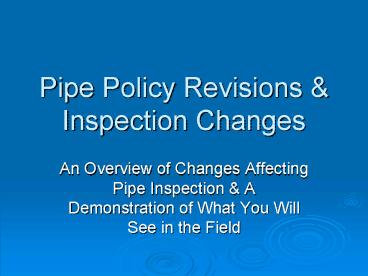Pipe Policy Revisions PowerPoint PPT Presentation
1 / 20
Title: Pipe Policy Revisions
1
Pipe Policy Revisions Inspection Changes
- An Overview of Changes Affecting Pipe Inspection
A Demonstration of What You Will See in the
Field
2
Agenda
- Pipe History
- Pipe Policy, Specification, KY Method Revisions
- Why?
- Equipment Inspection Demonstration
- Questions
3
KYTCs Pipe History Pipeline
- First Major Revision to fill height tables in the
Standard Drawings since 1977 was done on July 24,
1996. - Started the practice of bidding alternate
materials for pipes (before that designers
selected the material and specified it on the
plans) - Allowed HDPE for Culverts only
- HDPE not allowed on National Highway System or
Storm Sewer Applications
- October 30, 1996 Memo disallowing HDPE for
entrances in encroachment permits
- Several requests for using pipe materials outside
the Standard Drawings in the late 1990s - The requests prompted a policy letter from the
SHE office saying that projects requesting to use
materials outside the standard drawings required
SHE office approval - Over the years (with the help from some
conflicting e-mails from SHE office) this was
construed to mean that all projects required
approval to use HDPE, although the Standard
Drawings allowed it in certain cases
- May 12, 2005 Pipe committee was formed to
investigate current policy - Committee came to 3 primary conclusions
- HDPE should be allowed on storm sewer
- Standard Drawings should control allowable pipe
materials - More inspection of all the materials was needed
- Effective with the August 29, 2008 Bid Letting
there was a Revised SHE Pipe Policy, Revised Pipe
Inspection Specifications, and Revised KY Methods
for Pipe InspectionHERE ARE THE DETAILS
- First KYTC Policy Allowing HDPE, Set Forth in
Special Provision No. 95 in March of 1993 - Allowed HDPE for culvert and storm sewer
- Applied to Projects not on National Highway
System and with ADT lt4000
March 1993
July 1996
Oct. 1996
Late 90s - 2005
May 2005
August 2008
4
Revisions
- SHE Policy 2008-09
- PVC HDPE Allowed on NHS Storm Sewer
- Introduction of the Revised Specifications and KY
Methods - Projects Prior to the August 29th Letting May
Adopt these Revisions by Change Order
5
Revisions
- Supplemental Specifications Effective with the
August 29, 2008 Bid Letting - Main Points
- Requires Camera/Video Inspection of 50 of the
linear feet of installed pipe structures - Pipe under pavement to be selected first
- This is inclusive of ALL pipe types
- Inspection no sooner than 30-days after
completion of earthwork is within 1-foot of
finished subgrade - The inspection is looking for deflection,
cracking, joint separation, sagging, or other
interior damage - Deflections of corrugated metal or thermoplastic
pipes may require special analysis
6
Revisions
- Supplemental Specifications Effective with the
August 29, 2008 Bid Letting - Continued
- Pay Item for Inspection Pipeline Video
Inspection-by the linear foot
(1) Provide Structural Analysis as indicated
in the specifications. Based on the structural
analysis, pipe may be allowed to remain in place
at the reduced unit price.
7
Revisions
- Kentucky Method KM 64-114
- Main Points
- Instructions for completing the camera and laser
inspection - Instructions for determining the deflection
percentage - Instructions for submitting the inspection report
- Equipment criteria
- Camera Inspection Equipment
- The ability to pan and tilt to a 90 degree angle
with the axis of the pipe and rotate 360 degrees. - Equipped with low barrel distortion camera.
- Capable of producing color image with a minimum
standard resolution of 720 x 480 pixels. - Equipped with sufficient lighting to provide a
clear image of the full circumference of the
pipe. - Capable of recording the station, milepost,
distance along the invert of the pipe, or other
indicators of location superimposed on the video. - Capable of moving through entire length of pipe.
- Capable of measuring cracks greater than 0.1 and
joint separations greater than 0.5. - Laser Deflection Measuring device capable of
meeting the performance measures listed below.
These must be certified by a recognized
independent testing group. Certification testing
must be carried out in a field like condition. - Measuring deflection to an accuracy of 0.5 or
better and a repeatability of 0.12 or better. - Taking pipe profile calculations at a minimum
interval of 0.1 feet along the invert of the
pipe. - Inspection company must demonstrate experience
with their system. Submit the following
information with request for prequalification
8
Inspection Requirements
- Visually inspect all pipes
- Select 50 of the linear feet of pipe for
camera/video laser ring inspection - Do NOT indicate a pipe for inspection until after
installation - Do NOT allow inspection until 30-days after
completion of the fill to within 1 foot of the
final subgradeor if necessary, prior to
placement of final surface - Select pipes in complete runs (junction-junction
or headwall-headwall) - Select pipes under roadway first If the
selection of more pipe is necessary to meet 50,
randomly select pipes for inspection - If the inspection results show distresses
determine the remedial actions necessary to get a
sound product - If the distresses include metal or thermosplastic
pipe use the deflections percentage to determine
the remedial actionhere is some guidance
9
Field Expectations
- Strive to act uniformly
- Contact Central Office for assistance
- Use guidance where applicable
10
Why???
- To ensure that we minimize construction related
pipe problems - This is NOT just a thermoplastic pipe issue
- The revisions to the pipe policy and inspection
requirements were based on an analysis of the
in-place products we are seeing
11
Blockage(RCP, CMP HDPE)
12
Cracking(RCP)
13
Joint Offset(RCP HDPE)
14
Joint Separation(RCP HDPE)
15
Reinforcing Steel Showing(RCP)
16
Sags(HDPE)
17
Tearing Other(HDPE)
18
CompressedPipe(CMP HDPE)
19
HDWL Blocked
20
HDWL Settled/Faultedor Undercut
-
ltgt
-
ltgt

